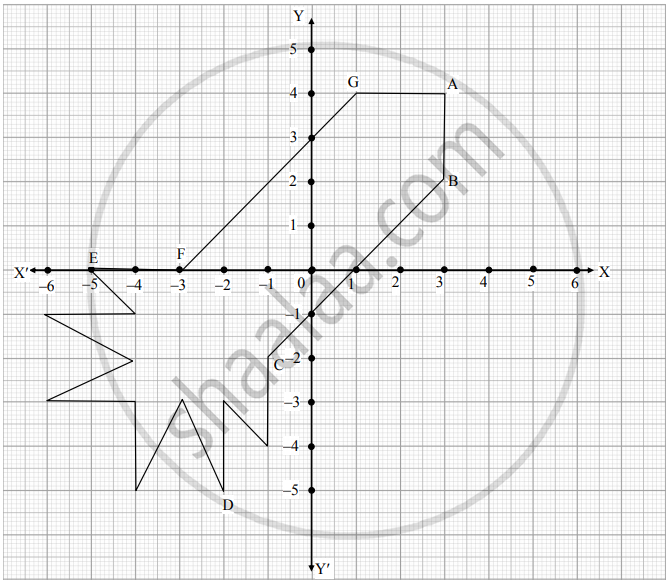Advertisements
Advertisements
Question
Find the points of trisection of the line segment joining the points:
5, −6 and (−7, 5),
Solution
The coordinates of a point which divided two points `(x_1,y_1)` and `(x_2, y_2)` internally in the ratio m:n is given by the formula,
`(x,y) = ((mx_2 + nx_1)/(m + n), (my_2 + ny_1)/(m + n))`
The points of trisection of a line are the points which divide the line into the ratio 1: 2.
Here we are asked to find the points of trisection of the line segment joining the points A(5,−6) and B(−7,5).
So we need to find the points which divide the line joining these two points in the ratio 1: 2 and 2: 1.
Let P(x, y) be the point which divides the line joining ‘AB’ in the ratio 1 : 2.
`(x,y) = (((1-(-7) + 2(5))/(1 +2 ))","((1(5) + 2(-6))/(1+ 2)))`
`(x, y) = (1, 7/3)`
Let Q(e, d) be the point which divides the line joining ‘AB’ in the ratio 2 : 1.
(e, d) = `(((1(5) + 2(-7))/(1 + 2))", "((1(-6) + 2(5))/(1 + 2))`
`(e,d) = (-3, 4/3)`
Therefore the points of trisection of the line joining the given points are `(1,7/3) and (-3, 4/3)`
APPEARS IN
RELATED QUESTIONS
Let ABCD be a square of side 2a. Find the coordinates of the vertices of this square when The centre of the square is at the origin and coordinate axes are parallel to the sides AB and AD respectively.
A (3, 2) and B (−2, 1) are two vertices of a triangle ABC whose centroid G has the coordinates `(5/3,-1/3)`Find the coordinates of the third vertex C of the triangle.
Prove that the points (0, 0), (5, 5) and (-5, 5) are the vertices of a right isosceles triangle.
Prove that the points (3, 0), (4, 5), (-1, 4) and (-2, -1), taken in order, form a rhombus.
Also, find its area.
Determine the ratio in which the straight line x - y - 2 = 0 divides the line segment
joining (3, -1) and (8, 9).
Find the area of quadrilateral ABCD whose vertices are A(-3, -1), B(-2,-4) C(4,-1) and D(3,4)
Find the ratio in which the point (−3, k) divides the line-segment joining the points (−5, −4) and (−2, 3). Also find the value of k ?
Show that the points (−2, 3), (8, 3) and (6, 7) are the vertices of a right triangle ?
Show that ΔABC, where A(–2, 0), B(2, 0), C(0, 2) and ΔPQR where P(–4, 0), Q(4, 0), R(0, 2) are similar triangles.
In \[∆\] ABC , the coordinates of vertex A are (0, - 1) and D (1,0) and E(0,10) respectively the mid-points of the sides AB and AC . If F is the mid-points of the side BC , find the area of \[∆\] DEF.
If x is a positive integer such that the distance between points P (x, 2) and Q (3, −6) is 10 units, then x =
If Points (1, 2) (−5, 6) and (a, −2) are collinear, then a =
If the centroid of the triangle formed by (7, x) (y, −6) and (9, 10) is at (6, 3), then (x, y) =
The point R divides the line segment AB, where A(−4, 0) and B(0, 6) such that AR=34AB.">AR = `3/4`AB. Find the coordinates of R.
The points (–5, 2) and (2, –5) lie in the ______.
Find the coordinates of the point whose ordinate is – 4 and which lies on y-axis.
If the vertices of a parallelogram PQRS taken in order are P(3, 4), Q(–2, 3) and R(–3, –2), then the coordinates of its fourth vertex S are ______.
Co-ordinates of origin are ______.
Ryan, from a very young age, was fascinated by the twinkling of stars and the vastness of space. He always dreamt of becoming an astronaut one day. So, he started to sketch his own rocket designs on the graph sheet. One such design is given below :

Based on the above, answer the following questions:
i. Find the mid-point of the segment joining F and G. (1)
ii. a. What is the distance between the points A and C? (2)
OR
b. Find the coordinates of the points which divides the line segment joining the points A and B in the ratio 1 : 3 internally. (2)
iii. What are the coordinates of the point D? (1)
